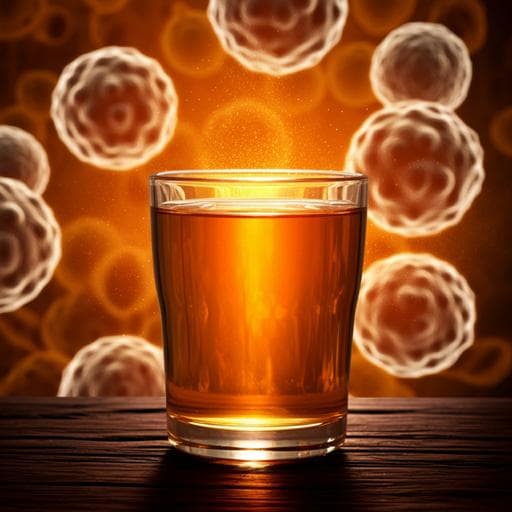
Food Science and Technology
Comprehensive studies on the properties of apple juice treated by non-thermal atmospheric plasma in a flow-through system
A. Dzimitrowicz, A. Bielawska-pohl, et al.
This innovative study led by Anna Dzimitrowicz and colleagues reveals how a non-thermal atmospheric plasma system can enhance the nutritional content and shelf life of apple juice without compromising its quality. The findings suggest potential antitumor activity against colorectal adenocarcinoma cells, opening new avenues in food treatment and cancer research.
~3 min • Beginner • English
Introduction
Apples are widely consumed for taste and nutrition. Prior studies used non-thermal atmospheric plasmas (NTAPs) to treat apple juices or fresh apple matrices due to their reactive oxygen and nitrogen species (ROS/RNS), affecting physicochemical and microbiological properties. However, earlier NTAP treatments were performed in stationary, non-flow systems with limited volume and potential uncontrolled plasma–liquid interactions, and mostly explored via one-factor-at-a-time approaches. The authors hypothesized that NTAP treatment of AJ in a continuous-flow reaction-discharge system, optimized by designed experiments, would improve nutritional value, shelf life, and quality without degrading bioactive compounds. The study aimed to optimize key parameters (discharge current, juice flow rate, electrode gap) to maintain the UV/Vis absorbance at 284 nm (indicative of phenolics) while elevating temperature below 50 °C to enhance microbial safety, and to evaluate nutritional, physicochemical, microbiological, and cytotoxic outcomes of the optimized NTAP-treated AJ.
Literature Review
Previous NTAP studies on apple juices examined effects on color, total polyphenols, non-enzymatic browning, titratable acidity, °Brix, cloud stability, polyphenol oxidase activity, total soluble solids, and pH. Microbiological inactivation of Escherichia coli, Citrobacter freundii, Zygosaccharomyces rouxii, Salmonella typhimurium, and Salmonella choleraesuis has been reported, improving shelf life and safety. Devices included atmospheric pressure plasma jets, spark discharge, glow discharge, dielectric barrier discharge, and KINPen systems; all operated in stationary mode with OFAT optimization, limiting throughput and multivariate insight. No prior work quantified elemental concentrations in NTAP-treated AJ. This study addresses these gaps by using a continuous-flow dc-APGD with flowing liquid cathode (FLC) and multivariate optimization.
Methodology
Materials: Commercial apple juice (filtered before plasma treatment). Reagents for Folin–Ciocalteu (F–C) and FRAP assays, microbiological media (TSA), and cell culture reagents were standard analytical grade.
NTAP system: Direct current atmospheric pressure glow discharge (dc-APGD) with AJ as a flowing liquid cathode (FLC) operated in a continuous-flow reactor. Discharge gap 3.0–5.0 mm between AJ surface (cathode) and sharpened tungsten anode. AJ delivered via quartz capillary with graphite tube; peristaltic pump flow 2.0–6.0 mL min−1. High voltage 1100–1300 V; discharge current 30–50 mA stabilized by a ballast resistor. Treated AJ collected immediately for analysis.
Design of experiments and RSM: Box–Behnken design (15 randomized runs, three factors: flow rate F 2–6 mL min−1, gap d 3–5 mm, current I 30–50 mA) with 3 center points. Responses: absorbance A at 284 nm (UV/Vis) and temperature T (°C). Quadratic response surface models with linear, square, and interaction terms; backward elimination at α=0.1 while maintaining hierarchy. Model adequacy assessed via ANOVA, R²/adjusted R², residual diagnostics. Desirability functions set to target A equal to untreated AJ (0.897) and maximize T ≤ 50 °C; composite desirability D computed.
Reactive species identification: Optical emission spectrometry (200–900 nm) recorded during continuous AJ introduction to identify ROS/RNS (NO, N2 second positive, OH, NH, H, O lines) and alkali emissions (Na, K) from plasma–liquid interaction.
Elemental analysis: ICP OES (Agilent 5110) measured total concentrations of major (Ca, K, Mg, Na), minor (Al, B, Fe, Mn, Sr), and trace (Ba, Cd, Co, Cr, Cu, Ni, Zn) elements. Sample prep: fivefold dilution and acidification to 1.0 mol L−1 HNO3; further dilutions for Ca, Mg (20×), K (200×), Na (2×). Calibration 0.02–2.00 mg L−1. Results as means (n=3) ± SD with spike recoveries to verify trueness. Water evaporation during NTAP quantified (11.0 ± 1.5%) and considered in interpretation.
Physicochemical analyses: ATR FT-IR (4000–400 cm−1, 4 cm−1, 64 scans) to assess organic structure; °Brix via refractometry on 20× dilutions; color by CIE L*a*b* (ΔE relative to water on 20× dilutions); total phenolics by F–C assay (gallic acid standard, mg GAE L−1); FRAP assay (TPTZ/Fe3+; absorbance at 593 nm; FeSO4 standard).
Microbiology: Plating 100 µL on TSA, incubation at 37 °C for 72 h. Tests for potential contamination post-NTAP and shelf-life assessment across groups: untreated/unfiltered, untreated/filtered, filtered/NTAP-treated, sampled at 0, 1, 2, 3, 5, 6, 12 days at room temperature (n=3).
Cytotoxicity: Cell lines Caco-2 (human colorectal adenocarcinoma) and FHs 74 Int (normal human intestinal epithelial, immortalized). Exposure to AJ dilutions (×1000, ×100, ×25, ×10) of untreated or NTAP-treated AJ in serum-free medium. MTT assay at 24 and 72 h (OD 570 nm). Apoptosis by Annexin V/PI flow cytometry at 24 and 72 h, quantifying alive, early/late apoptotic, and necrotic cells. Statistics via ANOVA with Dunnett’s post hoc; p<0.05 considered significant.
Key Findings
- DOE/RSM models: Absorbance model R²=76.3%, adjusted R²=66.8% (p=0.004); Temperature model R²=94.6%, adjusted R²=90.5% (p<0.001). Residuals were normal and independent.
- Optimal NTAP conditions: Flow F=6.0 mL min−1, gap d=4.0 mm, current I=50 mA; modeled responses A=0.897 (target) and T=44.8 °C; validation yielded A=0.897±0.010 (λ=284 nm) and T=47.8±0.6 °C.
- Reactive species detected by OES: NO (γ-system), N2 (second positive), OH (A–X), NH, H (486.1, 656.3 nm), O (777.2/777.4/844.6 nm); Na and K atomic lines from plasma–liquid interaction.
- Water loss: NTAP treatment caused 11.0±1.5% water evaporation.
- Elemental content: Apparent increases of 8–10% (Ca, Fe, K, Mg, Na, Sr) and 11–15% (Al, B, Ba, Cu, Mn, Zn). After correcting for water loss, differences vs untreated AJ were statistically insignificant (two-sample t-test, α=0.05).
- Organic composition and quality: ATR FT-IR spectra showed preserved functional group bands (O–H, N–H, C=O, C–O). °Brix essentially unchanged (13.1° untreated vs 13.0° NTAP-treated). Color ΔE vs water remained the same within SD (1.448±0.02 vs 1.456±0.01).
- Phenolics and antioxidant power: Total phenolics increased (Table 4: 167.6 to 205.6 mg GAE L−1; ≈22.7% unadjusted; adjusted value 185.4 mg GAE L−1 indicating ≈11% net increase after water-loss correction). FRAP increased from 7.07 to 7.93 mmol Fe(II) L−1 unadjusted; after correcting for water loss (7.14 mmol Fe(II) L−1) the FRAP was not significantly different from untreated.
- Microbiology and shelf life: No CFUs detected immediately after NTAP; process introduced no contamination. Shelf-life tests at room temperature showed untreated AJ developed CFUs by day 12, whereas NTAP-treated AJ remained at 0 CFU mL−1 at day 12, indicating shelf-life prolongation up to 12 days.
- Cytotoxicity: NTAP-treated AJ showed no cytotoxic effect on normal FHs 74 Int cells at tested dilutions and times. In Caco-2 cells, NTAP-treated AJ (×25, ×10) significantly inhibited proliferation after 72 h vs control and showed greater reduction in viability than untreated AJ at ×10 (p<0.05). Flow cytometry indicated increases in late apoptotic and necrotic fractions in Caco-2 (up to ~90% at ×10), while FHs 74 Int cells were not significantly affected at 72 h.
Discussion
The optimized continuous-flow dc-APGD NTAP process achieved the dual objective of preserving AJ’s phenolic-related UV/Vis absorbance at 284 nm while elevating product temperature below 50 °C, improving microbial safety without degrading quality. Multivariate optimization (DOE/RSM) identified critical roles of flow rate and current in controlling absorbance and temperature, avoiding overexposure of bioactive compounds typical of non-optimized treatments. Reactive species (NO, OH, N2) and modest heating likely underpin microbial control and shelf-life extension. Despite apparent increases in elemental concentrations and FRAP, correction for measured water loss demonstrated that the treatment did not materially alter mineral content or overall reducing capacity, while phenolic content increased modestly, possibly via enhanced release from plant material. The product’s color, °Brix, and FT-IR profiles remained stable, indicating maintained organoleptic and compositional integrity. Importantly, NTAP-treated AJ was non-cytotoxic to normal intestinal cells but selectively reduced viability of colorectal adenocarcinoma cells, consistent with ROS/RNS-mediated antitumor effects described for NTAP-treated systems. Collectively, these results support the applicability of a high-throughput, controlled NTAP process for producing safe, quality-preserved AJ with extended shelf life and potential added bioactivity.
Conclusion
A continuous-flow NTAP (FLC-dc-APGD) system was optimized via DOE/RSM to treat apple juice at F=6.0 mL min−1, d=4.0 mm, I=50 mA, maintaining phenolic-related absorbance while operating below 50 °C. Under these conditions, AJ retained mineral content (after accounting for 11% water loss), color, °Brix, FT-IR profiles, and FRAP, while exhibiting increased total phenolics (≈11% net), extended shelf life by up to 12 days, and selective cytotoxicity against Caco-2 cancer cells without harming normal intestinal cells. The flow-through configuration enables high-throughput processing and improved control compared with stationary systems. Future work could scale industrially, characterize specific phenolic profiles and sensory attributes, and further investigate mechanisms and in vivo relevance of the observed selective anticancer effects.
Limitations
Related Publications
Explore these studies to deepen your understanding of the subject.







